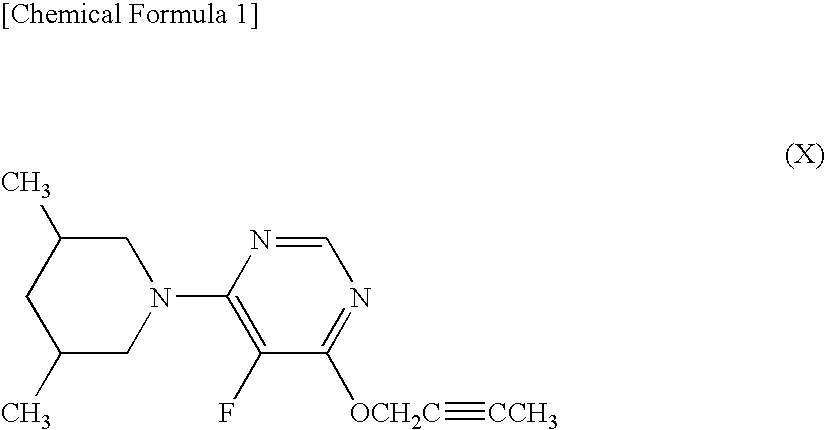Harmful organism control composition
a technology of composition and harmful organisms, applied in the field of pest control composition, can solve the problem that compounds do not necessarily have sufficient and achieve the effect of excellent efficacy in pest control
- Summary
- Abstract
- Description
- Claims
- Application Information
AI Technical Summary
Benefits of technology
Problems solved by technology
Method used
Image
Examples
reference example 1
[0249]A mixture of 0.22 g of N-(3-aminobenzoyl)-N′-ethoxycarbonylhydrazine, 0.31 g of 1-(3-chloro-2-pyridinyl)-3-trifluoromethyl-1H-pyrazole-5-carbonyl chloride and 10 mL of pyridine was stirred at room temperature for 2 hours. Water was poured into the reaction mixture, and a formed precipitate was collected by filtration to obtain 0.13 g of a compound I-(1).
[0250]1H-NMR (CDCl3, TMS) δ(ppm): 1.35 (3H, t, J=8 Hz), 4.29 (2H, q, J=8 Hz), 6.85 (1H, brs), 7.10 (1H, t, J=8 Hz), 7.24 (1H, s), 7.44 (1H, t, J=8 Hz), 7.47 (1H, dd, J=8 Hz, 4 Hz), 7.62 (1H, d, J=8 Hz), 7.93 (1H, d, J=4 Hz), 8.42 (1H, brs), 8.46 (1H, d, J=8 Hz), 8.52 (1H, d, J=8 Hz), 11.86 (1H, brs)
reference example 2
[0251]A mixture of 0.13 g of 1-methyl-1H-pyrrole-2-carboxylic acid, 0.15 g of thionyl chloride and 5 mL of hexane was heated to reflux for 2 hours. The reaction mixture was concentrated under reduced pressure to obtain 0.14 g of 1-methyl-1H-pyrrole-2-carbonyl chloride. To a mixture of 0.22 g of N-(2-aminobenzoyl)-N′-ethoxycarbonylhydrazine and 10 mL of pyridine was added 0.14 g of the resulting 1-methyl-1H-pyrrole-2-carbonyl chloride, and the mixture was stirred at room temperature for 2 hours. Water was poured into the reaction mixture, and a formed precipitate was collected by filtration to obtain 0.11 g of a compound I-(2).
[0252]1H-NMR (DMSO-d6, TMS) δ(ppm): 1.02-1.28 (3H, m), 3.91 (3H, s), 4.00-4.16 (2H, m), 6.13 (1H, d, J=4 Hz), 6.78 (1H, d, J=4 Hz), 7.06 (1H, m), 7.15 (1H, t, J=8 Hz), 7.56 (1H, t, J=8 Hz), 7.79 (1H, d, J=8 Hz), 8.57 (1H, d, J=8 Hz), 9.30 (1H, brs), 10.57 (1H, brs), 11.63 (1H, brs)
reference example 3
[0253]A mixture of 0.19 g of 1-methyl-3-trifluoromethyl-1H-pyrazole-5-carboxylic acid, 0.15 g of thionyl chloride and 5 mL of hexane was heated to reflux for 2 hours. The reaction mixture was concentrated under reduced pressure to obtain 0.14 g of 1-methyl-3-trifluoromethyl-1H-pyrazole-5-carbonyl chloride. To a mixture of 0.22 g of N-(2-aminobenzoyl)-N′-ethoxycarbonylhydrazine and 10 mL of pyridine was added 0.14 g of the resulting 1-methyl-3-trifluoromethyl-1H-pyrazole-5-carbonyl chloride, and the mixture was stirred at room temperature for 2 hours. Water was poured into the reaction mixture, and a formed precipitate was collected by filtration to obtain 0.23 g of a compound I-(3).
[0254]1H-NMR (DMSO-d6, TMS) δ(ppm): 1.20 (3H, t, J=8 Hz), 4.10 (2H, q, J=8 Hz), 4.19 (3H, s), 7.17 (1H, s), 7.28 (1H, t, J=8 Hz), 7.60 (1H, t, J=8 Hz), 7.79 (1H, d, J=8 Hz), 8.37 (1H, d, J=8 Hz), 9.02 (1H, brs), 10.41 (1H, brs), 11.50 (1H, brs)
PUM
| Property | Measurement | Unit |
|---|---|---|
| weight ratio | aaaaa | aaaaa |
Abstract
Description
Claims
Application Information
 Login to View More
Login to View More - R&D
- Intellectual Property
- Life Sciences
- Materials
- Tech Scout
- Unparalleled Data Quality
- Higher Quality Content
- 60% Fewer Hallucinations
Browse by: Latest US Patents, China's latest patents, Technical Efficacy Thesaurus, Application Domain, Technology Topic, Popular Technical Reports.
© 2025 PatSnap. All rights reserved.Legal|Privacy policy|Modern Slavery Act Transparency Statement|Sitemap|About US| Contact US: help@patsnap.com



